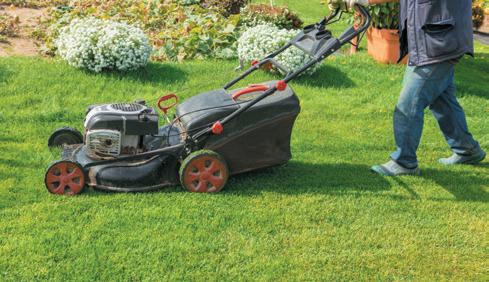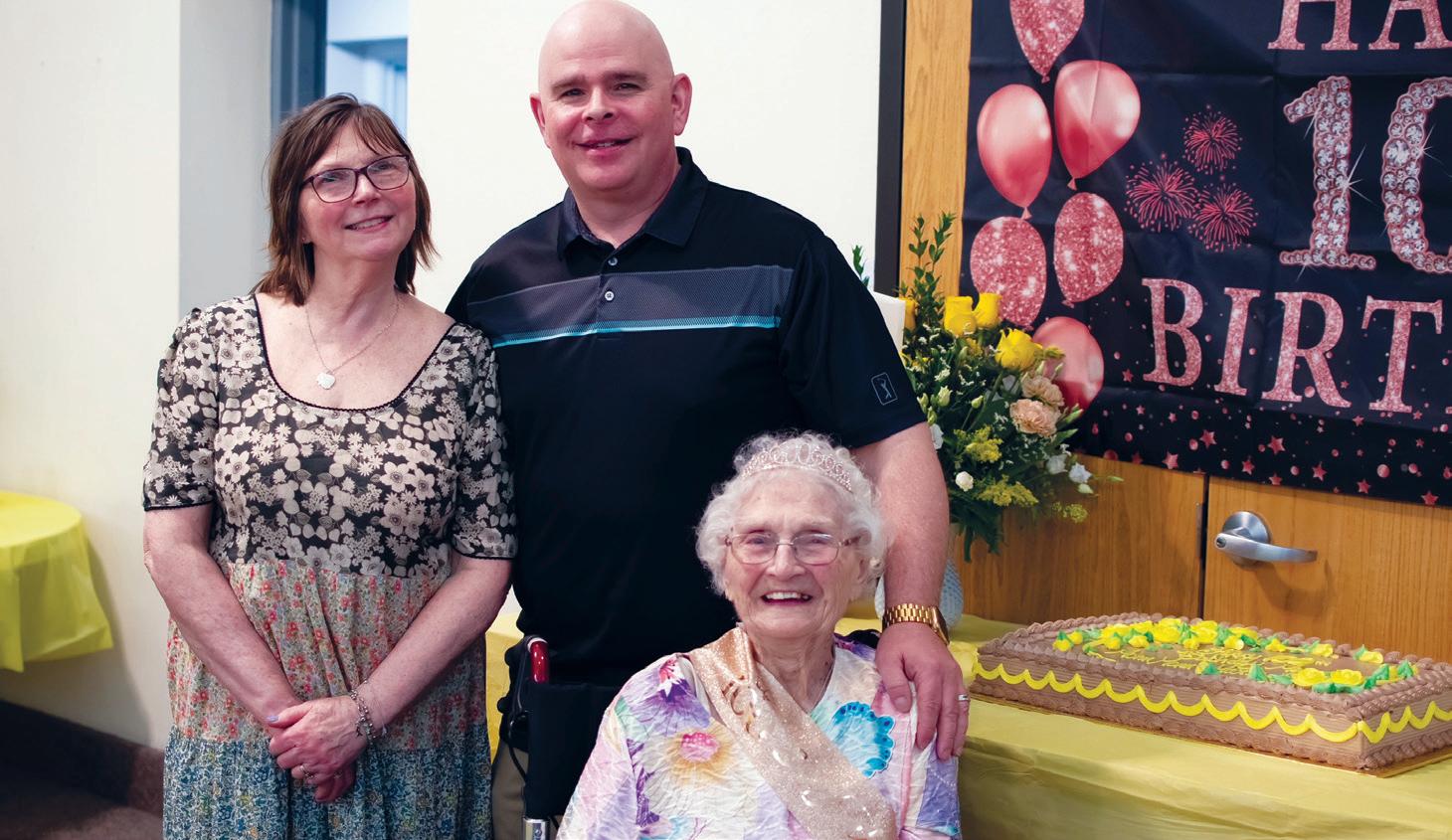
6 minute read
HEIRLOOM


Advertisement

(Continued from Page 1) has belonged since childhood and where she is now the oldest congregant.
“I guess I’m an heirloom,” is how she characterized that distinction.

Now, having just celebrated her 100th birthday on April 4, Kaelin reflected in a phone interview with the Pine Barrens Tribune about what farm life was like in these parts back in the 1920s and ‘30s, the changes she has lived through in the decades that followed, and how her many years of ‘living off the land’ while steering clear of things she considered detrimental to health may have contributed to not just her longevity, but her ability to remain sharp, active and quite literally ‘in harmony’ with much younger generations.
“I was raised on a 12-acre farm off Birmingham Road,” Kaelin replied when asked what her childhood was like. “There were 12 of us living in the house, including my brother, two sisters, my dad’s brother, his wife and two children, a single aunt and a single uncle.”
The house was one she described as a twostory brick structure with five bedrooms, but no indoor plumbing (outhouses only) and no power, being lit by gas lamps, which were also used in the barn. Refrigeration, she said, was provided by an old-fashioned icebox, which was chilled by “a big square piece of ice” that her uncle would usually bring back from town when he took a trip there to meet the milk truck with the farm’s output.
“Those chunks of ice lasted a couple days,” she remembered.


But then, she noted, “we were very selfsufficient in those days — and growing up on a farm, I always had regular chores,” which in her case included having to “hunt the eggs” laid by the free-roaming hens, and, along with her sister, “feed the dogs that were tied up at various stations in the yard,” carry wood from the woodpile and stack it in the inside shed, and use a hand pump to fill a tub in the milk house with fresh, cold water to “float the cans of milk in” overnight.



The neighborhood surrounding the farm, she noted, was also one lacking in paved roads, which could make for significant problems in getting around at times. An example she cited was when her grandmother passed away in March of 1936, and the roads were so muddy and rutted that her casket had to be transported via a horse and wagon down to Pemberton-Vincentown Road to meet up with a waiting hearse.
All-told, it was a far cry from the lifestyle of basic conveniences, to say nothing of technological luxuries, that most kids today as well as their parents have come to take for granted, such as heat in the winter, the only source of which in the family farmhouse was a wood stove in the dining room. The two front parlors, however, were “never heated,” she remembered—nor were the bedrooms.
“Our beds were so cold that we had to heat them with bricks that were put in the oven during the day,” she said. “Then at night, we’d wrap them in newspaper and put cloth around them – some kind of tapestry – and put that at the foot of the bed so we could warm our feet.” Another indication of just how frigid the children’s bedroom could get was the fact that the water in a stainless-steel pitcher that her parents would bring upstairs at night in case they got thirsty would often be frozen solid on winter mornings.
The lack of indoor plumbing also made bathing and washing clothes rather tedious routines, calling for a large wooden tub to be brought into the kitchen and “set on the floor next to the wood range,” which Kaelin said had a reserve tank on the side that was used to heat the bath water while the stove was on during the day.
“We had a bath once a week on Saturday night,” she said, noting that she and her sister frequently “used the same bath water when we didn’t have electric” to conserve hot water.



Getting clothes clean was an especially arduous procedure, requiring an aluminum tub and a scrub board.
Not that such “having to do without” applied to everything in her childhood. The family, she said, did have a telephone during that time –albeit one connected to a party line (which was shared with other neighborhood residents) -- and a piano, which proved very important to Kaelin’s later life (more on that in a moment).
When electricity did finally make its appearance in the Simon family’s residence, it initially arrived in a kind of transitional form known as a Delco Light Plant, an ingenuous, if now largely forgotten system, which Kaelin recalled as consisting of a “service battery” set up in the basement that was operated by eight or 10 smaller batteries, and which is described on an Internet site as a compact, lightweight unit producing 750 watts of power on average, which operated automatically so as to only work when needed, being primarily intended to serve as a decentralized power supply for farms (although it was also used by some businesses). It was also one that necessitated having to buy “special appliances,” such as a mixer and an iron, to be used with it, she said.


The addition of a bathroom to the house, however, was the work of her husband, Vernon Kaelin, whom she married in 1947 and stayed married to for the next 54 years until his death – and who, from her description, could have been the paradigm of the totally self-sufficient American, being both a farmer and the owner of a service station at the corner of Arneys Mount and Fort Dix Roads (known at various times as Kaelin’s Friendly Tydol, Kaelin’s Flying A, and Kaelin’s Getty). Besides being proficient at doing all the plumbing himself for that bathroom installation, she noted, he went on to build a home with the help of his brother-in-law, Joe Haines, from fieldstones he dug up while clearing the land on a 40-acre spread he purchased on N. Pemberton Road in 1954 — one still owned by his wife (who continued to reside in it until moving in with Houwen, whose own house is a on a six-acre parcel of that property she was deeded by her father so as to conform to the township building code).
“My husband didn’t need the services of professionals – he was a handy guy,” Kaelin quipped.
But Kaelin was no slouch herself when it came to being handy – not only in her dual role as a ‘farm wife’, doing such chores as canning commodities, including sides of beef for use over the winter, and spending roughly seven hours at a stretch mowing the lawn on their property, and as the spouse of the owner of a service station for which she oversaw bookkeeping and payroll responsibilities as well as helping to wash cars, but as a salaried professional in her own right – a sort of pacesetter at a time following the allhand-on-deck demands of the Second World War when most married women had more or less reverted to an unassertive, stay-at-home lifestyle.

In fact, right after graduating from Pemberton High School in 1940, she was proficient enough in mathematics to be hired as a bookkeeper by Sterling Davis Dairy in Wrightstown, an operation that had more than two dozen employees engaged in selling milk to the military at Fort Dix, in which she was given the job of overseeing the payroll and writing checks to area farmers.

“I worked there for 13 years and retired just two weeks before my daughter was born,” she recollected. But years later, when Natalie, was in the eighth grade, she went back to work, spending another 26 years keeping attendance records for the Pembertown Township Board of Education before retiring a second time in 1992 to help care for her grandson, who was born two months premature, since Natalie worked as a teacher. (Kaelin, however, was given a keepsake of that job – one of the attendance books she so meticulously kept.)
Through all these different phases of her life, however, Kaelin managed to continue pursuing her lifelong passion for music, serving St. Paul’s in various roles that included pianist and associate music director for the Vacation Bible School, as well as singing in the choir for a period spanning more than 65 years – an avocation she also trained for during a childhood that was otherwise somewhat short on frills.

“We always had a piano,” she emphasized. “My father’s sister could play, and my sister Elizabeth and I took lessons for 50 cents a week and had to practice an hour a day. In addition, she was exposed to music at an early age by dint of having a phonograph in the house – not a record player, but an earlier wind-up model owned by her German-born grandmother that played round cylinders, which she said mostly contained hymns. So, by the time she joined the choir at St. Paul’s following her confirmation at 13, she already well-versed in gospel music and was also proficient enough on the piano, along with her sister, for the two of them to play duets on holidays.
When asked by this newspaper about her personal tastes in music, however, they turned









